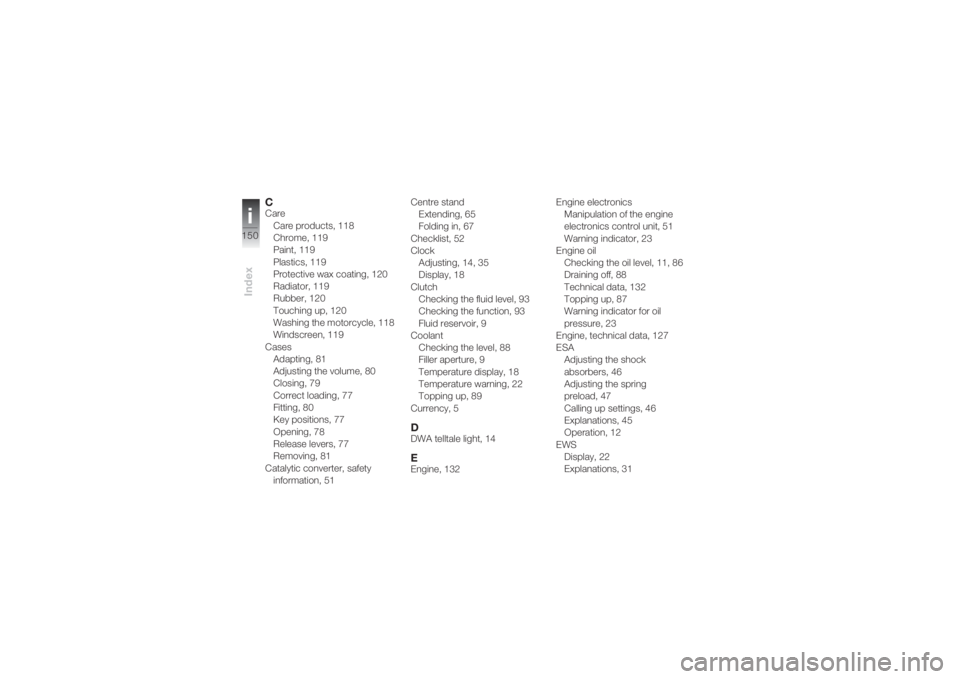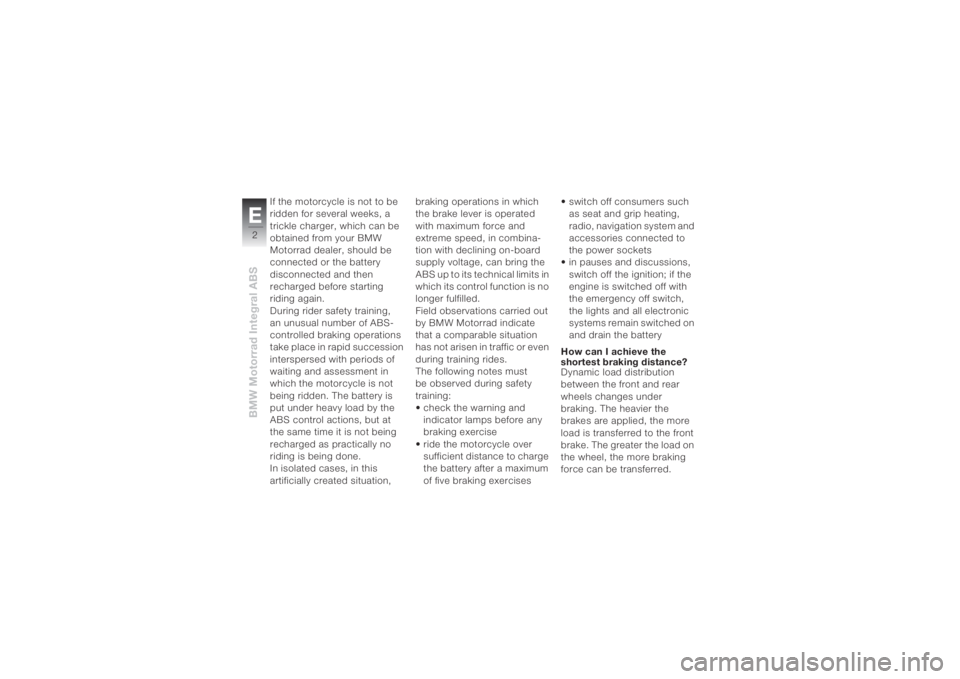Page 152 of 162

Indexi150
CCare
Care products, 118
Chrome, 119
Paint, 119
Plastics, 119
Protective wax coating, 120
Radiator, 119
Rubber, 120
Touching up, 120
Washing the motorcycle, 118
Windscreen, 119
Cases
Adapting, 81
Adjusting the volume, 80
Closing, 79
Correct loading, 77
Fitting, 80
Key positions, 77
Opening, 78
Release levers, 77
Removing, 81
Catalytic converter, safety
information, 51Centre stand
Extending, 65
Folding in, 67
Checklist, 52
Clock
Adjusting, 14, 35
Display, 18
Clutch
Checking the fluid level, 93
Checking the function, 93
Fluid reservoir, 9
Coolant
Checking the level, 88
Filler aperture, 9
Temperature display, 18
Temperature warning, 22
Topping up, 89
Currency, 5
DDWA telltale light, 14EEngine, 132Engine electronics
Manipulation of the engine
electronics control unit, 51
Warning indicator, 23
Engine oil
Checking the oil level, 11, 86
Draining off, 88
Technical data, 132
Topping up, 87
Warning indicator for oil
pressure, 23
Engine, technical data, 127
ESA
Adjusting the shock
absorbers, 46
Adjusting the spring
preload, 47
Calling up settings, 46
Explanations, 45
Operation, 12
EWS
Display, 22
Explanations, 31
Page 154 of 162

Indexi152
Luggage
Safety information, 50
Strapping, 42MMotorcycle equipment, 5
Multifunction display, 14NNeutral, telltale light, 18PParking light, 38
Bulb, 15
Replacing the bulb, 108
Parking your motorcycle, 61, 65
Power socket,9,74,136
Pre-ride check, 53RRear light, replacing the
bulb, 108
Rear shock absorber
adjustment, 9Rear spring preload
adjustment, 9
Rear wheel stand, 104
Replacement keys, 32
Resetting the odometer, 34
Residual braking function, 71
Residual range, 34
Restoring to use, 121
Rev. counter, 14
Rider’s equipment, 6
Running in
Brake pads, 58
General information, 58
SSafety check before a
journey, 52
Safety instructions, 50
Seat
Installing, 41
Lock, 9
Placing down, 40
Removing, 40Securing the steering lock, 31
Sensor for instrument cluster
lighting, 14
Shifting gear, 59
Side stand
Folding in, 63
Position on starting, 55
Unfolding, 61
Spark plugs, technical data, 135
Speed
Safety information, 50
Technical data, 138
Speedometer, 14
Splash guard, 116
Starter, 13
Starting, 56
Symbols, 4
TTechnical data
Bolt connections, 124
Dimensions and weights, 137
Electrical system, 135
Engine, 127
Page 160 of 162

BMW Motorrad Integral ABSE2
If the motorcycle is not to be
ridden for several weeks, a
trickle charger, which can be
obtained from your BMW
Motorrad dealer, should be
connected or the battery
disconnected and then
recharged before starting
riding again.
During rider safety training,
an unusual number of ABS-
controlled braking operations
take place in rapid succession
interspersed with periods of
waiting and assessment in
which the motorcycle is not
being ridden. The battery is
put under heavy load by the
ABS control actions, but at
the same time it is not being
recharged as practically no
riding is being done.
In isolated cases, in this
artificially created situation, braking operations in which
the brake lever is operated
with maximum force and
extreme speed, in combina-
tion with declining on-board
supply voltage, can bring the
ABS up to its technical limits in
which its control function is no
longer fulfilled.
Field observations carried out
by BMW Motorrad indicate
that a comparable situation
has not arisen in traffic or even
during training rides.
The following notes must
be observed during safety
training:
• check the warning and
indicator lamps before any
braking exercise
• ride the motorcycle over
sufficient distance to charge
the battery after a maximum
of five braking exercises• switch off consumers such
as seat and grip heating,
radio, navigation system and
accessories connected to
the power sockets
• in pauses and discussions,
switch off the ignition; if the
engine is switched off with
the emergency off switch,
the lights and all electronic
systems remain switched on
and drain the battery
How can I achieve the
shortest braking distance?
Dynamic load distribution
between the front and rear
wheels changes under
braking. The heavier the
brakes are applied, the more
load is transferred to the front
brake. The greater the load on
the wheel, the more braking
force can be transferred.Info_I_ABS_en_xx.fm Seite 2 Dienstag, 19. Juli 2005 2:48 14
Page:
< prev 1-8 9-16 17-24